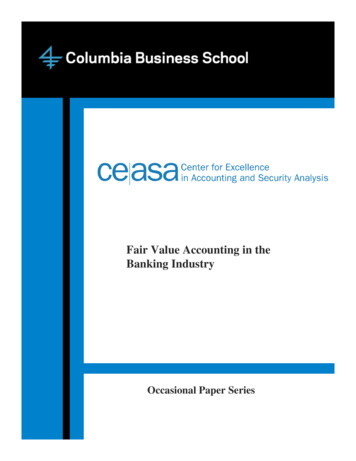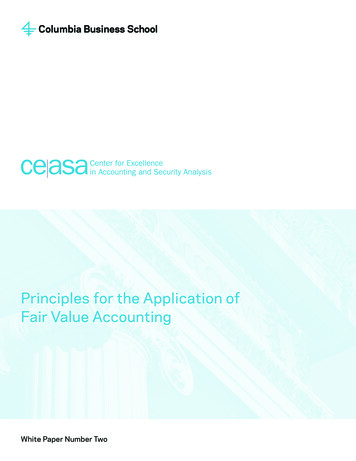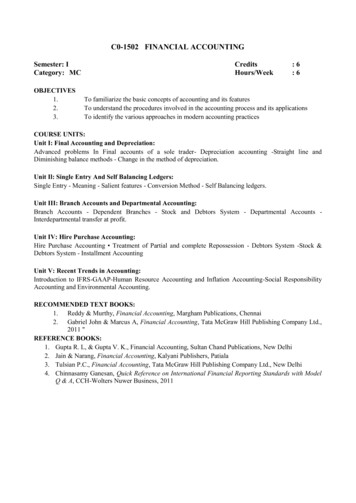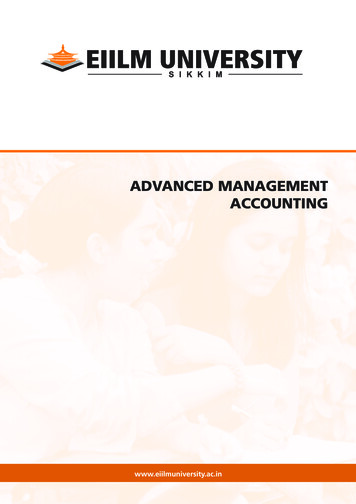
Transcription
Fair Value Accounting in theBanking IndustryOccasional Paper Series
Center for Excellence in Accounting & Security AnalysisColumbia Business School established the Center for Excellence in Accounting and SecurityAnalysis in 2003 under the direction of Trevor Harris and Professor Stephen Penman. TheCenter (“CEASA”) aims to be a leading voice for independent, practical solutions forfinancial reporting and security analysis, promoting financial reporting that reflects economicreality and encourages investment practices that communicate sound valuations.CEASA’smission is to develop workable solutions to issues in financial reporting andaccounting policy; produce a core set of principles for equity analysis; collect and synthesizebest thinking and best practices; disseminate ideas to regulators, analysts, investors,accountants and management; and promote sound research on relevant issues. Drawing onthe wisdom of leading experts in academia, industry and government, the Center producessound research and identifies best practices on relevant issues. CEASA's guiding criterion isto serve the public interest by supporting the integrity of financial reporting and theefficiency of capital markets.Located in a leading university with a mandate for independent research, CEASA ispositioned to lead a discussion of issues, with an emphasis on sound conceptual thinking andwithout obstacles of constituency positions.More information and access to current research is available on our website athttp://www.gsb.columbia.edu/ceasa/The Center is supported by our generous sponsors: General Electric, IBM and MorganStanley. We gratefully acknowledge the support of these organizations that recognize theneed for this center.
FAIR VALUE ACCOUNTING IN THE BANKING INDUSTRYPrincipal ConsultantDoron Nissim; Professor, Columbia Business School; Chair of the AccountingDepartment, Columbia Business SchoolProject CoordinatorStephen Penman; George O. May Professor of Accounting, Columbia BusinessSchool; Co-Director, CEASAMay 2007
Table of ContentsOVERVIEW.3I.INTRODUCTION .4II.BANKS’ FINANCIAL STATEMENTS AND PROFITABILITY.10A.B.C.D.III.Sample . 10Common-Size Balance Sheets. 11Common-Size Income Statements. 13Profitability . 15ANALYSIS OF ASSETS.18A.B.C.Cash and Balances Due from Depository Institutions. 18Federal Funds Sold and Securities Purchased under Agreements to Resell. 20Securities. 22C.1. Accounting Treatment and Classification . 22C.2. Unrealized Gains and Losses . 24C.3. Composition and Risk . 25C.4. Estimation and Limitations of Fair Value . 30C.5. Academic Research. 31D. Trading Assets . 32E. Loans and Leases. 33E.1. Accounting Treatment and Classification . 33E.2. Composition. 35E.3. Risk Exposures. 36E.4. Estimation, Accuracy and Limitations of Fair Value . 39E.5. Academic Research. 42F. Other Financial Assets. 44G. Premises and Equipment. 45H. Intangible Assets. 46I. Other Assets. 49IV.ANALYSIS OF LIABILITIES.51A.B.C.Federal Funds Purchased and Securities Sold under Agreements to Repurchase . 51Trading Liabilities . 52Deposits . 53C.1. Accounting Treatment, Composition and Risk . 53C.2. Estimation of Fair Value . 55C.3. Academic Research. 56D. Debt. 56D.1. Accounting Treatment and Composition . 56D.2. Risks and Estimation of Fair Value . 57Center for Excellence in Accounting & Security Analysis 1
E.V.D.3. Academic Research. 57Other Liabilities . 58DERIVATIVES AND OFF-BALANCE-SHEET ITEMS .59A.B.C.D.E.VI.General. 59Commitments. 60Letters of Credit. 61Credit Derivatives. 62Derivatives (Other than Credit) . 64E.1. Accounting Treatment. 64E.2. Classification . 66E.3. Composition and Risk . 68E.4. Estimation of Fair Value . 69E.5. Academic Research. 70CONCLUSION .71REFERENCES .72Center for Excellence in Accounting & Security Analysis 2
OverviewThis paper studies the application of fair value accounting in bank holding companies in the UnitedStates with the purpose of evaluating the effects of expanding fair value accounting in the bankingindustry.The paper documents the current application of fair value accounting in the industry, showing whatproportions of recognized assets and liabilities of bank holding companies are at or close to fair valueon the balance sheet, have related unrealized gains and losses in income, or have fair values disclosedin the footnotes. In each case, it evaluates the advantages and disadvantages of the current treatmentand makes an assessment of the magnitudes of economic assets and liabilities that currently areomitted from the balance sheet. Turning to the issue of the likely impact of expanded application offair values, the paper asks how large are the actual and potential differences between fair values andbook values of various assets and liabilities and how credit, interest rate and prepayment risks arelikely to determine those differences. It considers the availability of market-based information formeasuring fair value and evaluates the correlations between fair values of economic assets andliabilities due to natural hedges, asset-liability management, and changes in asset values affecting therisk and value of liabilities. It also addresses the issue of how a switch to fair value accounting wouldmitigate or, alternatively, facilitate earnings management activities.The primary conclusion of the analysis is that expanding fair value accounting is not likely tosignificantly improve the information in bank financial statements and, in some cases, may introducedistortions that reduce accounting quality. The analysis is pertinent to bank analysts and investors for itnot only documents the impact of fair value accounting on banks but also informs about the drivers ofvalue and risk on which accounting should report.Center for Excellence in Accounting & Security Analysis 3
I.IntroductionThis paper studies the application of fair value accounting in the U.S. banking industry. Its primaryobjective is to inform on the applicability of fair value accounting in the banking industry and thedesirability of adopting standards which will expand fair value reporting. To achieve this goal, thisresearch presents relevant evidence that addresses the following issues and questions:(a) The current application of fair value accounting1) What proportions of recognized assets and liabilities of bank holdingcompanies (BHCs) are reported at or close to fair value on the balance sheet,have related unrealized gains and losses recognized in income, or have fairvalues disclosed in footnotes?2) What are the magnitudes of economic assets and liabilities which areomitted from the balance sheet?(b) The likely impact of implementing fair value accounting on various assets,liabilities, and off-balance sheet items3) For each item, how large are the actual and potential differences betweenfair and book values?4) How important are credit, interest rate, and prepayment risks? (Thisanalysis is important because high risk implies high likelihood of significantdifferences between fair and book values; in addition, the precision of pricingvaries across exposures.)5) What is the availability and quality of market-based information formeasuring fair value?6) What are the fair value correlations with other economic assets andliabilities, and what are the sources of these correlations (e.g., natural hedge,asset-liability management, impact of changes in assets value on the risk andvalue of liabilities)?(c) The accounting treatment of various assets, liabilities, and off-balance sheet items7) What is the current accounting treatment and what are its advantages anddisadvantages?8) How can banks “manage” the balance sheet and income statement?9) How would a switch to fair value accounting mitigate or alternativelyfacilitate earnings management activities?10) How can GAAP be improved?While the primary objective of this research is to study the impact of fair value accounting on BHCs,the analyses also inform on drivers of value and risk in the banking industry and discuss relatedaccounting issues. Therefore, the paper should also be of interest to bank analysts, investors, and otherusers of financial information.The empirical analysis utilizes data from essentially all regulatory consolidated financialstatements (FR Y-9C reports) submitted by BHCs to the Federal Reserve System for the quartersQ1:2001 through Q3:2005. These reports contain uniform and detailed calendar year-to-date incomeCenter for Excellence in Accounting & Security Analysis 4
statements, end-of-quarter balance sheets, and supplementary information. Under the Bank HoldingCompany Act, BHCs with total consolidated assets of 150 million or more, or that satisfy certainother conditions (e.g., have public debt), are required to file FR Y-9C reports on a quarterly basis.Thus, the sample covers essentially all of the banking industry during the five years 2001 through2005. This period is characterized by significant volatility in interest rates and economic activity,making the results reasonably representative. 1 The empirical evidence is corroborated with insightsobtained by examining a sample of 10-Ks.During the sample period, more than 90% of reported BHCs’ assets and essentially all of theirliabilities consisted of financial instruments. These statistics, however, should be interpretedcautiously. For many BHCs, major economic assets are either omitted from the balance sheet orreported at nominal amounts. Such assets include intangibles related to traditional banking activities,such as core deposit and lending relationships. They also include human capital and technologyintangibles, which allow banks to generate fees and other sources of non-interest income fromactivities such as investment banking, asset management and securitizations. While BHCs do notprovide fair value information for these assets, their magnitudes are likely to be substantial. Forexample, during the sample period, total non-interest income across all banks was of similar magnitudeto net interest income. In addition, for many BHCs, the contribution of core deposits to net interestincome (that is, the reduction in interest expense due to the use of deposit liabilities instead of capitalmarket debt to fund assets) is the largest source of income. Thus, while almost all reported assets andliabilities are financial instruments, large portions of economic assets and liabilities are not. Thisobservation has important implications for the application of fair value accounting for BHCs.Advocates of fair value accounting often argue that essentially all of the assets and liabilities of banksare financial instruments, which are generally easier to mark-to-market compared with other assets andliabilities. The present analysis indicates that this is not the case.The existence of significant intangibles has the following additional implications. First,intangible assets are particularly difficult to value, even when compared with other non-financialassets. In general, valuing intangibles requires making predictions about future operations, includingdemand and cost data, while many tangible assets can be valued using appraisals or exit values. Thus,allowing banks to recognize the estimated fair values of internally-developed intangibles may lead tosignificant errors and biases in financial reports. Second, the fair values of bank intangibles are often1Under some conditions, fair value accounting may be more or less informative than suggested by our results. For example,large unexpected changes in interest rates or credit spreads may lead to increased usefulness of fair value information.Center for Excellence in Accounting & Security Analysis 5
correlated with those of recognized financial instruments, implying that marking-to-market thefinancial instruments without fair valuing the intangibles may distort book value and earnings. Forexample, the core deposit intangible typically increases in value when interest rates rise, offsetting thedecline in the value of fixed rate loans. As another example, the volume of securitizations, and hencesecuritization gains, typically increase when interest rates decline, offsetting the decline in the value ofservicing rights.Another issue with fair valuing intangible assets is related to the definition of fair value. Theabove discussion assumes a “value in use” definition—the fair value of an asset is equal to the presentvalue of net cash flows associated with using the asset. An alternative definition, which has beenadopted by the FASB and IASB, is market or exit value. Since most intangibles are not actively traded,firms would have to estimate exit values in order to fair value intangibles. This introduces additionalmanagerial discretion in estimating fair value (what portion of the value in use cannot be realized insale due to asymmetric information or unique synergies?).On average, 36% of banks’ reported assets (cash and balances due, federal funds sold,securities purchased under resell agreements, available-for-sale securities, and trading assets) and 16%of their liabilities (federal funds purchased, securities sold under repurchase agreements, and tradingliabilities) were reported on the balance sheet at or close to fair value. Another 52% of assets (loans,held-to-maturity securities, and other financial assets) and 34% of liabilities (time deposits and debt)were subject to Statement of Financial Accounting Standard (SFAS) 107 and SFAS 115 fair valuedisclosure requirements. 2 Thus, for approximately 88% of BHCs’ reported assets and 50% of theirliabilities, fair value estimates were generally available during the sample period.While significant portions of assets and liabilities are reported on the balance sheet at fairvalue, the resulting unrealized gains and losses are reported primarily in other comprehensive income.The most significant exceptions are trading instruments which, for very large BHCs, constitutesignificant portions of assets and liabilities. However, for most small and mid-sized banks, reportedincome reflects little, if any, unrealized gains and losses.Most financial assets and liabilities are currently accounted for by using the effective interestrate method. Under this method, book value is equal to the present value of promised cash flows,discounted using the historical at-issue yield. Consequently, unrealized gains/losses are due to changesin the instruments’ yield, which in turn are due to instrument-specific factors (e.g., changes in the2Some financial instruments (e.g., leases) are excluded from the scope of SFAS 107. In addition, SFAS 107 specifies thatthe disclosed fair value of deposits with no stated maturity should be the amount payable on demand, which typicallyoverstates the economic liability.Center for Excellence in Accounting & Security Analysis 6
issuer’s credit risk) or to market exposures (e.g., changes in interest rates or in the market pricing ofcredit risk). When the term structure of interest rate is not flat, yield changes also result from thepassage of time. For example, when the at-issue term structure has a positive slope (as is typically thecase), market yields on existing financial instruments decrease as their times-to-maturity shorten,resulting in unrealized gains. There are two possible fixes to the distortion caused by such predictableunrecognized gains and losses. One is to use fair value accounting. The other is to continue to usehistorical cost accounting, but to measure periodic interest with at-issue forward rates instead of theiraverage (i.e., the at-issue yield).BHCs classify investments in securities as either available-for-sale (95% of securities, 16% ofassets) or held-to-maturity (5% of securities, 1% of assets). Available-for-sale securities are reportedon the balance sheet at fair value, but the resulting unrealized gains/losses are excluded from incomeand reported as part of other comprehensive income. Held-to-maturity securities are accounted for byusing the effective interest rate method, but their fair values are disclosed in a supplementary schedule.To inform on the economic impact of switching to full fair value accounting for securities, statisticsfrom the distribution of unrealized securities gains/losses were examined. During the sample period,unrealized gains and losses were small for most BHCs. Thus, implementing full fair value accountingfor securities during the sample period would have had a relatively small effect.All derivatives are reported on the balance sheet at fair value (2% of assets, 2% of liabilities).Unrealized gains and losses on derivatives, other than those used for hedging cash flows orinvestments in foreign operations, are reported in income. Almost all derivatives are classified astrading (96% of notional value, 97% of fair value), implying that essentially all unrealized derivativegains and losses are reported in income. Similar to securities and other financial instruments, the riskassociated with derivatives depends on their notional amounts. However, unlike other financialinstruments where book value is close to the notional amount, the book value of derivatives—which isequal to their fair value—is significantly smaller than their notional amount. Thus, while derivativesaccount for only 2% of assets and 2% of liabilities, their contribution to risk is substantially larger.This is especially true, given that banks appear to use derivatives for trading rather than hedging. Thefact that hedge accounting is hardly used by banks implies that bank balance sheets reflect little, if any,marking-to-market of hedged assets and liabilities.To evaluate whether BHCs generate value from investments in interest-bearing cash balances(2% of assets), federal funds sold (1% of assets), and securities purchased with resell agreements (5%of assets), the distribution of excess yields on these instruments was examined. Large BHCsCenter for Excellence in Accounting & Security Analysis 7
consistently generate significant excess returns, suggesting the existence of economic intangiblesrelated to these investments. In contrast, for small and mid-size BHCs, these investments appear to bevalue-neutral activities.Fair value estimates are available in FR Y-9C reports only for selected assets and liabilities,and analysis of excess yields is meaningful only in the context of short-term instruments with trivialrisk. Therefore, to evaluate the potential magnitude of unrealized gains/losses on other assets andliabilities, the risks associated with the related activities were analyzed (low risk implies that thelikelihood of significant differences between the fair and book values is relatively small).The types and magnitudes of exposures vary considerably across assets and liabilities. While mostbanks’ financial instruments are subject to interest rate risk, the primary exposure for many loans iscredit risk. In contrast, the primary exposure for mortgage-backed securities is prepayment risk, andcredit risk is either trivial or of secondary importance (most mortgage-backed securities, whichconstitute the majority of investment securities, are either issued, guaranteed or insured by U.S.government entities). Most banks’ derivatives are over-the-counter interest-rate contracts which, unlikeexchange-traded derivatives (where the exchange serves as the counterparty), are subject to credit risk.In addition, some large BHCs have significant exposures to credit derivatives. Still, the primaryexposure for most derivatives is interest rate risk. Deposits contribute to bank value by providing arelatively cheap source of funds, compared with capital market funds. Thus, the economic risksassociated with deposits include the risk of early withdrawals and the potential for a narrowing of themargin between the costs of market funds and deposits. Since most time deposits are either short-termor variable rate (about 84% of time deposits), and carry significant early withdrawal penalties, the riskof withdrawal prior to maturity is relatively small. Still, banks typically expect substantial renewals ofmatured time deposits, and so face the risk of excessive withdrawals at maturity. For deposits with nostated maturity (more than 70% of total deposits), the key risk is that actual growth will fall belowexpectations (or the rate of decline will be larger than expected).The analysis of the relative magnitudes, composition, and characteristics of the different assetsand liabilities is important not only because it indicates the potential for unrealized gains/losses, butalso because the precision of pricing varies across exposures. Whereas the pricing of interest rate riskis relatively simple and non-discretionary, that of credit and prepayment risks involves substantialdiscretion and complications. Thus, this analysis informs two aspects of fair value accounting: (1) thepotential effects on the financial statements of marking-to-market assets and liabilities, assuming thatCenter for Excellence in Accounting & Security Analysis 8
fair values are measured precisely; and (2) the potential effects of measurement error and bias in fairvalue estimates.Overall, the empirical analyses conducted in this study suggest that for most BHCs, thedifference between the market and book values of equity is due primarily to expected earnings fromfuture activities, with the difference between the fair and book values of existing assets and liabilitiesbeing of a secondary importance. This is especially true for BHCs with strong customer relationshipsor significant investments in technology or human capital. Thus, even if one takes a balance sheetperspective for financial reporting (as opposed to an income statement approach, which emphasizes theconcept of “permanent income”), implementing fair value accounting with respect to existing assetsand liabilities has a limited potential for improving accounting quality. Also, given the estimationerrors and potential biases involved in measuring the values of intangible assets, it is not likely that fairvaluing intangibles will improve accounting quality.The paper proceeds as follows. Section II examines the composition of BHCs’ balance sheetsand income statements, and the profitability of various activities. Section III analyzes the differentasset categories and related income items, while Section IV examines liabilities and related costs.Section V discusses derivatives and off-balance sheet items. Section VI concludes the discussion withrecommendations and implications.Center for Excellence in Accounting & Security Analysis 9
II.Banks’ Financial Statements and ProfitabilityA. SampleThe sample includes essentially all regulatory consolidated financial statements (FR Y-9C reports) thatBHCs submitted to the Federal Reserve System for the 19 quarters Q1:2001-Q3:2005. 3 The number ofobservations per quarter ranges from 1,572 to 2,332, and generally increases over time. The totalnumber of observations is 38,323 (2,691 different BHCs). The BHCs range in size (total assets) from 38 million to 1,547,789 million. The median size is 341 million, the lower quartile is 221 million,and the upper quartile is 713 million.We conduct all analyses for five samples: (1) firm-quarter observations with total assets lessthan 1 billion (small BHCs); (2) firm-quarter observations with total assets between 1 billion and 10 billion (mid-sized BHCs); (3) firm-quarter observations with total assets between 10 billion and 100 billion (large BHCs); (4) firm-quarter observations with total assets greater than 100 billion(very large BHCs); and (5) all BHCs. We partition the sample based on bank size because substantialresearch demonstrates (and our analysis confirms) that size is a good proxy for differences in businessmix and strategy. We recognize, of course, that size is not the only relevant partitioning variable.Table II(A)(1) presents statistics for the size distribution of each sample. As shown, “very largeBHCs” constitute only 1% of the observations, but account for almost 70% of total assets of thebanking industry. In contrast, “small BHCs” constitute more than 80% of the observations, but accountfor less than 5% of total assets.To better present the economic significance of assets, liabilities and other financial statementitems, we focus in the empirical analysis below on financial ratios calculated using aggregate data foreach sample. That is, each ratio is calculated by dividing the total of the numerator across all samplefirm-quarter observations by the total for the denominator. The resulting ratios are in effect weightedaverages of the individual bank-quarter ratios, with weights proportional to size (a
This paper studies the application of fair value accounting in bank holding companies in the United States with the purpose of evaluating the effects of expanding fair value accounting in the banking industry. The paper documents the current application of fair value accounting in the industry, showing what










